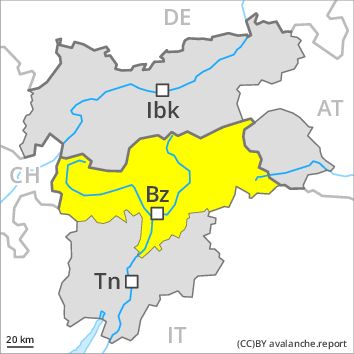Regions
Sexten Dolomites, Eastern Pfunderer Mountains, Durreck Range, Val Müstair Alps, Western Rieserferner Mountains, Langtaufers, Western Deferegger Alps, Schnals Ridge, Ortler Range, Southern Stubai Alps, Ulten Valley, Southern Zillertal Alps and High Tauern, Eastern Nonsberger Alps, Saldurn-Mastaun Ridge, Northern Dolomites of Fiemme, Texel Mountains, Gröden Dolomites, Sarntal Alps, Prags Dolomites, Western Pfunderer Mountains

Danger level
Avalanche Problem
Wind-drifted snow above the treeline, N-NE-E-SE-S-SW-W-NW
Gliding snow above 2400m, N-NE-E-SE-S-SW-W-NW

Fresh wind slabs require caution.
As a consequence of a strong to storm force wind, sometimes deep wind slabs formed in particular adjacent to ridgelines and in gullies and bowls. The avalanche prone locations are to be found in all aspects above approximately 2000 m. The wind slabs represent the main danger. Mostly avalanches are medium-sized. The number and size of avalanche prone locations will increase with altitude. Snow sport activities outside marked and open pistes call for meticulous route selection. Remotely triggered and natural avalanches are possible in isolated cases. The avalanche prone locations are prevalent and are barely recognisable because of the poor visibility. As the penetration by moisture increases more small and medium-sized gliding avalanches are possible below approximately 2400 m.
Snowpack
The fresh and older wind slabs remain for the foreseeable future prone to triggering in all aspects above approximately 2000 m. As a consequence of the southerly wind the wind slabs will increase in size additionally. They are lying on soft layers. On wind-loaded slopes a precarious avalanche situation will be encountered over a wide area. The wind will be storm force. Slight warming.
Tendency
The avalanche danger will persist. Wind slabs require caution.